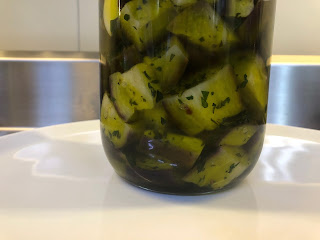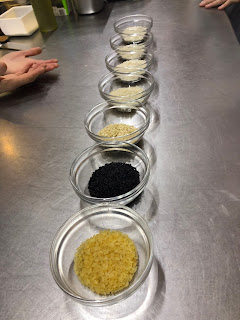Day 2 & 3: The Formal Meal - Antipasti & Pasta
The Formal Meal - Antipasti
In Italy, the government uses classifications for certain foods to show tradition or signify the quality of something. I am going to explain each to you!DOP: Denominazione di origine protteta; the ingredients must be Italian and the making must happen in the specific region, place, or village
Some products classified as DOP:
Aceto balsamico tradinxionale di Modena
Basilico Ligure
Carciofo spinoso di sardegna
Pecorino Romano
Proscuitto crudo di Parma
IGP: Indicazione geografica garantita, the production transformation and or elaboration happen in a specific area (but the ingredients could come from another country)
Some products classified as IGP:
Aceto Balsamico di Modena
Mortadella di Bologna
Pane di Matera
Carciofo Brindisino
STG: Specialita tradizionale grantita, the production happens with traditional methods from the specific region or place
Slow Food: A global,
grassroots organization founded in 1989 to prevent disappearance of local food
cultures and traditions, counteract the rise of fast life and combat people's
dwindling interest in the food they eat, where it comes from and how our food
choices affect the world around us
*The difference
between slow food and DOP is DOP comes from the government, a law, a
requirement, where slow food is decided by the people (not a law form the
government)
Today in class, we preserved eggplant in oil and also fennel & carrots. This was a process I had not seen before, but it was very interesting. We were able to try the preserved vegetables from the class before and the next class will try ours.
We also made brodetto di cozze e fagioli which is similar to Cioppino. Cioppino is a dish originating from San Francisco by an Italian fisherman. Putting these two together, I believe that the Italian man really wanted the traditional meal, but invented Cioppino because of the ingredients he had. He used any fish that he had, also something Italian people do because they do not like to waste things. This was a take on what he had know before.
Pasta
Many people believe that pasta was brought back from China by Marco Polo, but this was not the case. When Marco Polo went to China, in his book he wrote that the noodles he was eating reminded him of a dish back home, therefore he was already aware of it. Pasta was already known during Roman time because in tombs in Tuscany, they found drawings of the tools needed to make pasta. There are no recipes that date that far back, which is because it was so common that no one needed to write it down. Pre-Roman time, they made noodles similar to lasagna noodles, broke them up, and put it into broth. Pasta dough was useful because it can be dried and stored for a very long time and it is very simple to make: just water and flour.
During Roman time, the population increased significantly in just 500 years. They did not have the logistics to feed this many people, so they could only really produce things with flour and water. People began giving grains to people for free to show their wealth. Things like meat, pork, chicken, veggies, etc. were very limited because of the amount of people and the storage space that there was. Puglia and Sicily were the grain producers for the entire Roman empire.
Mezzelune is the Italian word for crescent. This pasta dish below is called Messelune e funghi, which is a pasta filled with a cheese fondue and served with a mushroom sauce. This dish originates from the mountains of Northern Italy, mainly because of the use of buckwheat flour. This flour was used because it was more hearty, but it does not stretch at all. This dish had very rich flavors and was extremely flavorful of the outdoors.
I was able to make ravioli today, which was very cool because this is something my grandmother makes at home. This dough was very elastic due to the fact of the use of 00 flour. The ravioli was filled with a 4 cheese mixture, which was absolutely delicious!
Fun Fact of the Day:
Discuss an Italian perspective on Italian Cuisine.
I am going to change this question a little into what is the difference between Italian Cuisine and American Italian Cuisine. Italian cuisine involves the freshness of ingredients, while in America, we throw cheese on it and call it Italian! Dishes like fettuccine Alfredo are not a thing here (Sorry Kristi!). What you see and get at Olive Garden are American Italian dishes, not Italian dishes. It is not just about pasta here, it is really more of a focus on vegetables and knowing where your ingredients are coming from.
With Love,
Discuss an Italian perspective on Italian Cuisine.
I am going to change this question a little into what is the difference between Italian Cuisine and American Italian Cuisine. Italian cuisine involves the freshness of ingredients, while in America, we throw cheese on it and call it Italian! Dishes like fettuccine Alfredo are not a thing here (Sorry Kristi!). What you see and get at Olive Garden are American Italian dishes, not Italian dishes. It is not just about pasta here, it is really more of a focus on vegetables and knowing where your ingredients are coming from.
With Love,
Baylee Mello








Comments
Post a Comment